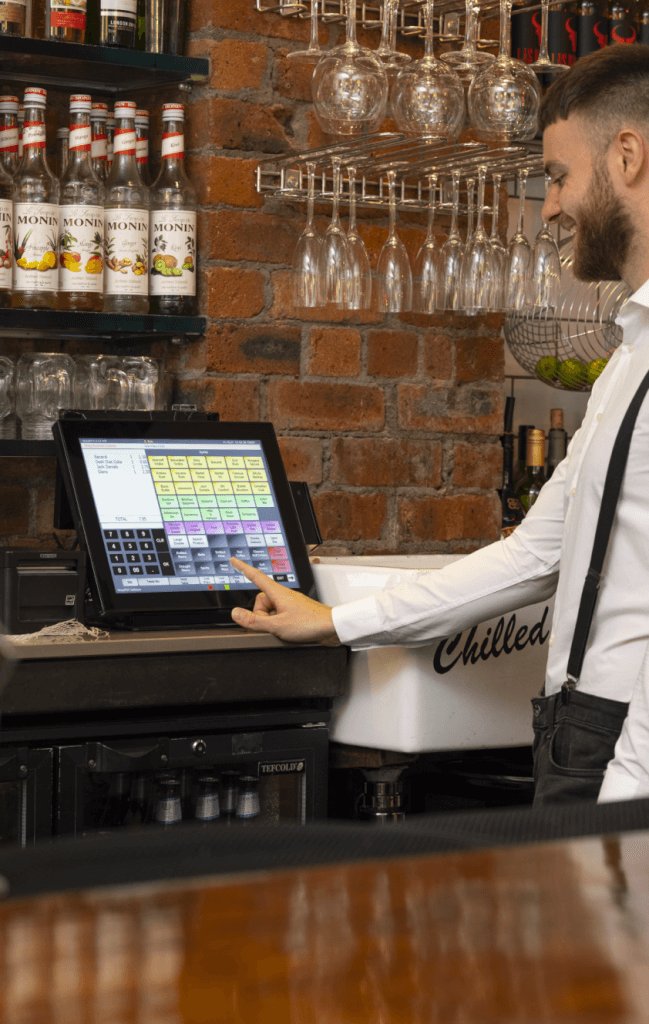The benefits of a two-way integration between electronic point-of-sale systems and table management systems for hospitality venues can be significant when it comes to providing a great dining experience for your customers. With industry experts Lumina Intelligence reporting year-on-year growth of £5.4 billion in 2022 for the restaurant industry, it is more important than ever to connect your systems and stay ahead of the growing competition.
As a table management system, ResDiary integrates with EPOS systems to offer a superior dining experience. Oracle Micros and Tevalis are two EPOS systems that can be integrated with ResDiary. This integration allows you to automatically and accurately input data through these systems, helping staff to manage bookings and walk-ins, maximise covers, offer marketing programs and track sales.
Here's what you need to know about EPOS systems and how integrating yours with a TMS like ResDiary can benefit your business operations.
What is an EPOS system?
EPOS stands for electronic point-of-sale. In simple terms, an EPOS system is a till for the modern world. Primarily, they process payments and allow businesses to interact with customers. EPOS systems can also be used for inventory management, storing customer data and more.
EPOS solutions are cloud-based – meaning data is stored and managed on external servers – and are frequently updated with new features. They can also be integrated with other services to improve efficiency and offer greater insights.
EPOS system hardware
When you think of an electronic point-of-sale system, you probably think of its hardware. EPOS hardware is centred around a terminal. This can be a large monitor or something more discreet like a tablet.
In order for an EPOS system to function, peripheral components are necessary. These include card readers and receipt printers. In the case of a retail EPOS system, a barcode scanner is an essential addition.
These components connect to the central terminal and provide everything you need to smoothly process transactions.
EPOS system software
Software is what makes EPOS systems really tick. There are many different pieces of EPOS software out there, which can be customised depending on your industry.
More technophobic businesses might opt for cheap, simple POS software that features the bare minimum needed to process transactions. On the other end of the spectrum, EPOS software can be used for advanced customer data collection, allowing you to more easily measure essential data like sales, profits and customer favourites. Some even include marketing tools and built-in loyalty programs.
If you integrate your EPOS software with other pieces of business operational software, you can come away with some extremely valuable insights. For example, you can integrate your EPOS and table management systems. You can also automatically update your TMS when meals are served or bills are paid. This allows for easy and automated data collection.
You can also show data from your TMS on your EPOS during live service. Staff can keep an eye on customers' booking information, allowing them to adjust and adapt in real-time. This leads to greater customer satisfaction, better word-of-mouth and more returning visitors.
EPOS systems for hospitality businesses
As a hospitality business owner, your electronic point of sale system is an essential tool for efficiently processing transactions. You need to be able to consistently rely on your EPOS system as without it, your operations will come to a screeching halt.
Additional features offered by EPOS systems can also be indispensable for your hospitality venue. Here are a few properties found in many EPOS systems which can benefit your hospitality venue:
-
Custom menus for different areas of the venue.
-
Custom special offers.
-
Easy recording of all sales.
-
Central updating of menus and customer information.
-
Intelligent inventory management features, reducing food waste.
-
Loyalty programs.
What is a table management system?
Table management systems are useful platforms that can bolster your business operations in a number of ways. They track and optimise table usage within your restaurant, helping you to reduce wait times and increase turnover.
Some table management systems go above and beyond to offer a suite of features to help your business. Here are just some of the features offered by ResDiary:
- Table reservation management.
- Yield Management.
- ResPhone – automated telephone booking service.
- Group Central Reservations.
- Event Management.
- Email and SMS marketing.
ResDiary also offers integrations with over 60 hospitality technologies, including EPOS providers, sharing data and functionality for streamlined and holistic business operations.
Benefits of integrating EPOS systems with table management systems
Processing card transactions
A core function of any point-of-sale technology is the processing of digital transactions. POS systems compute the cost of a number of items – for example, the cost of a drink, burger and chips – and, with the tap of a credit card, the transaction between buyer and seller can be completed.
A digital or physical receipt can then be printed or dispatched and the inventory for that particular item can be updated to reflect the transaction.
The process is quick, easy and removes the human error that may be involved in working out what was ordered, calculating costs and organising the correct amount of change. Depending on the program, an electronic point-of-sale system can be connected to tablets so payments can be processed anywhere in the venue. Some EPOS systems also offer flexible forms of payment, including split bills.
Reporting and analytical tool
Some EPOS systems provide businesses with real-time data and reports covering a range of customer preferences and decisions. SumUp, another ResDiary integration, offers access to a wide range of reports, including but not limited to:
- Turnover
- Profit margins
- How to identify bestsellers with ease.
You’ll also be able to keep an eye on inventory management and avoid over or under-stocking with our real-time reporting feature to help you react instantly to dynamic stock movements. This means you get a deeper insight into your operation, at a glance.
Online orders
A useful feature that’s incorporated in certain EPOS systems, such as Bleep, is online orders for delivery, takeaway or eat-in. Bleep excels in providing bespoke, innovative EPOS systems designed specifically for the fast service industry, such as fast food outlets, sandwich shops, bakeries, butchers and delicatessens.
The features of connecting an EPOS system to a table management service like ResDiary may vary depending on the software. Before settling on an EPOS system, conduct research, and find the one that is most suitable for your hospitality venue. To find out more, consider booking a personalised demo for your venue.
How do EPOS systems work?
Usually, a hospitality electronic point of sale system works by tracking which products have been purchased by a particular table, collating all the data for one easy transaction. It connects with other hardware like card readers and receipt printers to streamline the purchase even more.
Additional hardware such as a barcode scanner may also be necessary, though this would most commonly be found in a retail EPOS system.
Different types of EPOS systems
Countertop EPOS system
The most commonly-found EPOS system is a countertop EPOS system. These systems run from a central monitor which uses your EPOS software of choice to process transactions. This monitor sits alongside other pieces of transaction hardware to be easily used when customers come to the counter to make their payments.
Countertop EPOS systems are robust and simple to use, but they lack versatility. For example, there's no option to take your countertop EPOS system to your customer's table to process their payment.
Tablet EPOS system
Tablet EPOS systems are fundamentally very similar to countertop systems. You can place a tablet on a counter alongside your other EPOS hardware and not notice much of a difference compared to a countertop system other than the size of the screen.
Tablets also allow for increased versatility, as you can take your tablet around the restaurant and process orders and transactions. This can be particularly useful if you are serving customers who are elderly, or who live with a disability.
Mobile EPOS system
That's right, you can even run an EPOS system on a mobile or handheld device. This can be a great option for new small businesses with very little initial capital to spend on more expensive options.
However, running a more complex EPOS system on such an undersized device might not be for everyone. Operating complicated functionality with a mobile EPOS system can prove difficult and hold up your transactions.
Frequently asked questions
Which payments can EPOS systems accept?
It isn't hard to find a good EPOS system that will allow you to accept just about any payment type. EPOS systems can connect to tills to collect cash payments and to card processors to accept credit cards, debit cards and mobile payments like Apple Pay and Google Pay.
There are even specialised EPOS systems that you can use to accept payments from Buy Now, Pay Later (BNPL) providers like Afterpay and even cryptocurrencies like Bitcoin.
Are EPOS systems secure?
Yes, provided you work with reputable brands and take the proper precautions, modern EPOS systems are secure. Do plenty of research into your EPOS providers and keep your EPOS software updated so you and your customers are always protected.
How do you set up an EPOS system?
Here is a generic guide to setting up an EPOS system. Remember that you will need to consult your specific provider to ensure you set up your system correctly.
- Plug in your terminal and receipt printer.
- Connect to Wi-Fi or ethernet.
- Connect your terminal to your cash drawer.
- Add your inventory to your system.
- Add users and apply the proper administration settings for each user.
- Add your payment methods to your EPOS system.



